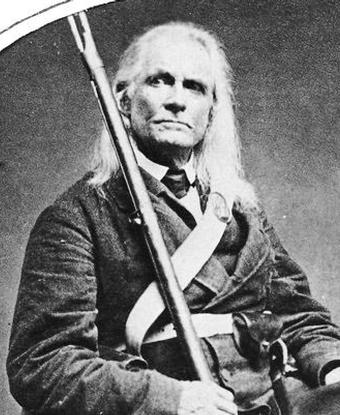Last updated: November 10, 2018
Person
Edmund Ruffin

National Archives and Records Administration
Edmund Ruffin, the father of soil science, achieved notoriety for his outspoken views on slavery, states’ rights, and secession. Born to a wealthy Virginian planter family in 1794, Ruffin began in his twenties experimenting with ways to rejuvenate the depleted soil of his native state, which suffered from the monoculture of tobacco. He advocated crop rotation and the use of marl, or lime, to improve the soil by reducing acidity. In addition to his work in agriculture, Ruffin served as a private in the Virginia militia during the War of 1812 and later held political office as a state senator.
By the 1850s, Ruffin’s attention became increasingly drawn to politics. He advocated for secession years before it became reality. Events, however, soon outpaced even Ruffin’s prediction of secession. John Brown’s raid on the Federal arsenal at Harpers Ferry in 1859 alerted southerners to the extent of pro-abolitionist sentiment in the North. Ruffin traveled to witness Brown’s execution and later purchased several of the pikes Brown and his men had carried to send to southern governors as a reminder of the intent of abolitionists.
The presidential election of 1860 saw the Democratic Party split along geographic lines. Ruffin and other Fire-Eaters, known for their support of slavery and secessionist rhetoric, traveled throughout the South, urging states to secede and form a new government. Ruffin was present in Charleston on December 20, 1860 when South Carolina became the first state to secede from the Union.
In his 1860 book, Anticipations of the Future, to Serve as Lessons for the Present Time, Ruffin predicted civil war would come in 1868 with the re-election of the hated William H. Seward, that the first shots of that war would be fired at Fort Sumter, and that the South would be victorious.
On April 12, 1861 Ruffin, now a private in the Palmetto Guard and stationed on Morris Island, fired a shot from a 64-pounder columbiad at Fort Sumter, one of the first shots fired of the American Civil War. Days after the Confederacy’s first victory at Fort Sumter, Ruffin was overjoyed to hear his native Virginia had seceded. A hero for his role at Fort Sumter, Ruffin spent the early stages of the war traveling to battlefields to rally the troops.
As the fortunes of the war turned against the Confederacy and Union forces made greater incursions into Virginia, Ruffin stopped traveling and abandoned some of his properties, spending the end of the war at his farm in Amelia County, Virginia. After hearing the news of the surrender of Lee’s Army of Northern Virginia at Appomattox Court House and being in poor health, Ruffin decided to end his life rather than live under the Stars and Stripes again. He committed suicide on June 17, 1865 at the age of seventy-one and was later interred at his Virginia plantation, Marlbourne.
“And now with my latest writing and utterance, and with what will [be] near to my latest breath, I here repeat, & would willingly proclaim, my unmitigated hatred to Yankee rule—to all political, social and business connections with Yankees, & to the perfidious, malignant, & vile Yankee race.”
